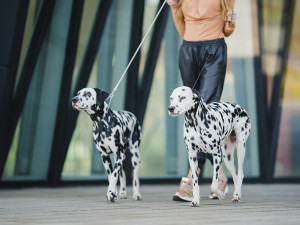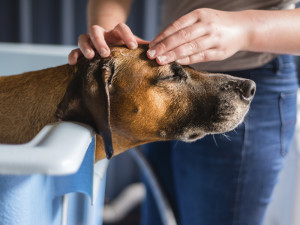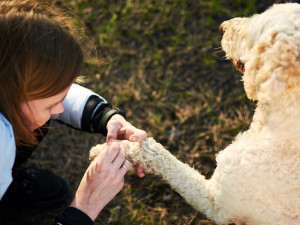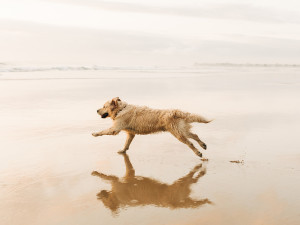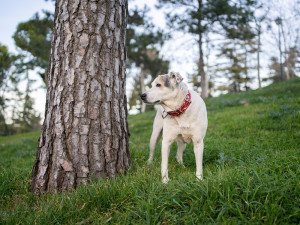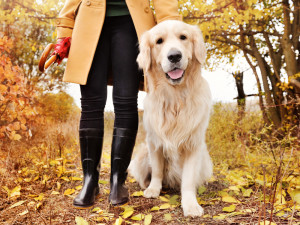Why Does My Dog Walk Sideways?
It may not be anything serious, but you should understand the causes.
In This Article:
Normal Reasons for Sideways Walking Why Does My Old Dog Walk Sideways Why Is My Dog Walking Sideways All of a Sudden? Medical Conditions Causing Sideways Walking
Dogs walking sideways, also known as crabbing or sidewinding, is a peculiar sight. While this behavior can be a quirk or a temporary adjustment to physical changes, it could also be a sign of underlying health issues, like hip dysplasia or vision problems, that require attention.
Normal reasons for sideways walking
A dog can walk sideways for many reasons and in many different ways. Some dog parents want to know why their dog always walks at an angle when on a leash. Other dogs seem to walk sideways after grooming or when they’re excited. Becoming familiar with your dog’s normal gait and behaviors can help you to recognize what’s normal and spot problems when they arise.
Breed-specific tendencies
Some breeds are more likely to do a type of sideways walking called “crabbing” when they’re trying to trot. This is due to the mechanics of trotting in dogs. During a trot, legs diagonal from each other move at the same time. This type of gait results in a forelimb in a slightly back position when a hindlimb on the same side comes forward.
How much do you spend on your pet per year?
Most dogs can trot in a straight line, but dogs with long legs relative to their body length can have trouble with this because their hind foot wants to land where their front leg is planted. To avoid their legs getting tangled, they’ll trot at a slight angle so their legs are no longer perfectly aligned. Some dog breeds that may display crab walking include:
German Shepherd Dogs
Doberman Pinschers
Border Collies
Some Spaniel breeds
Excitement
Parents of active dogs (especially puppies) may wonder, Why does my dog walk sideways when excited? Dogs will often move at an angle or almost completely sideways when they’re excited about something.
They may be using the change in angle to look back at you to make sure you’re coming along to share in their excitement. Many dogs will curve their bodies and hop or stand sideways away from you during play as well. This behavior is perfectly normal, and just means you’re part of the fun.
Temporary physical adjustments
When walking on rough trails or hiking in hilly areas, it’s expected that dogs will adjust their gait to account for any obstacles or steep angles they encounter. Dogs will naturally try to find the body position that allows them to stay as steady as possible. At times, this could mean that they’re walking at an odd angle.
Leash pressure
Dogs tugging on a neck lead will often walk at an angle because they’re straining against the limits of the leash and their back end can move forward more freely than their front end. This can be helped by proper leash training and using a chest harness instead of a neck lead.
Why does my old dog walk sideways?
A senior dog walking sideways is most commonly due to pain or a balance issue. If your older dog has a sudden change in the way they’re walking, alert a veterinarian as soon as possible.
It could indicate muscle or joint pain, idiopathic vestibular disease, back pain, or a neurological condition. Getting your senior dog examined by your vet can help to get to the cause of sideways walking and hopefully get them comfortable and walking normally quickly.
Why is my dog suddenly walking sideways?
While many dogs may normally walk sideways, a sudden change in your dog’s gait, body posture, or balance may indicate a problem. Some causes may be obvious. Dogs wearing new clothes (including sweaters, jackets, ThunderShirts, booties, or harnesses) can walk crooked as they adjust to their new gear. On rare occasions, pet parents may notice that their dog is walking sideways after grooming. For hairy dogs who were shaved, this could be a reaction to the unfamiliar feel of the breeze moving across their skin. Grooming can also involve holding up limbs in unusual ways or being put in awkward positions. For dogs with arthritis, this can result in muscle or joint soreness that affects their gait.
If you don’t recognize an obvious trigger for your dog’s sideways walking, you can check them over for causes. Things like scratches, burrs caught in hair, thorns in paws, or rocks between toes can all cause dogs to contort their bodies as they walk. If you’re not picking up on a reason for your dog to be walking sideways, get them checked out by your vet. It may be nothing, but it’s always better to be safe than sorry.
Medical conditions causing sideways walking
Walking sideways isn’t always normal for dogs. Some dogs can have a crabbing gait or sidewinding due to medical issues. Getting to the root of these problems may involve consultation with your primary vet or a veterinary surgeon or neurologist. Some possible causes for sideways walking in dogs include:
Neurological diseases
Many neurological issues can cause loss of balance and incoordination. Some brain issues are lateralizing, meaning they affect one side of the body more than the other. This can result in a gait that leans or falls to one side consistently. Neurological issues can include congenital disorders like hydrocephalus, cerebellar hypoplasia, or caudal occipital malformation syndrome (COMS).
Hydrocephalus: Dogs with hydrocephalus have an excessive amount of cerebral spinal fluid (CSF) where their brain should be. This condition has many possible causes but is most often due to improper drainage of CSF from the brain. Chihuahuas are one of the most commonly affected breeds.
Cerebellar hypoplasia: The cerebellum is a part of the brain whose primary function is to control muscle function and balance. Some puppies can be born with an underdeveloped cerebellum due to prenatal issues like viral infections, lack of oxygen, or exposure to birth-defect-causing drugs or toxins.
COMS: Also called a Chiari-like malformation or syringomyelia, COMS is a condition in which there is not enough space in the skull for the brain to fit. This results in compression of the back part of the brain (where the cerebellum and brain stem sit), leading to gait issues. Cavalier King Charles Spaniels are particularly prone to this, though most flat-faced breeds are at risk due to their skull conformation.
Acquired neurological issues can result in sideways walking as well. Head trauma can result in either short-term or permanent gait abnormalities. Brain inflammation due to autoimmune diseases or infections can also cause dogs to have balance issues that result in crab walking. Infectious causes include conditions like toxoplasmosis, cryptococcosis, neosporosis, and tick-borne diseases.
Vestibular disease
Idiopathic vestibular disease in dogs is a common cause of balance loss. Dogs with vestibular disease usually have a head tilt and loss of balance. They will often roll or fall to one side. Idiopathic vestibular disease has no known cause (that’s what “idiopathic” means) and tends to show up in older dogs.
Vestibular disease can also be caused by middle- or inner-ear infections that cause inflammation of the ear structures that help control balance. Dogs with a loss of balance due to vestibular disease take days to weeks to return to normal, and they may walk sideways while they’re recovering.
Hip dysplasia
For a dog with hip dysplasia, walking in a perfectly straight line may cause discomfort. Dogs with hip dysplasia often sway their hips when walking or have a bunny-hopping gait. When one hip is more painful than the other, this can result in an angled or sideways gait. Dogs with hip dysplasia also tend to shift as much weight as possible to their forelimbs to reduce movement of their hind limbs.
Intervertebral disc disease
There’s a rubbery disc between each of the bones of a dog’s spine. These discs serve as “bumpers” to help protect the bones from injury and allow the spine to move more freely. With wear and tear, the tougher outer part of a disc can weaken, allowing the softer material within to be squeezed out.
This material can press against the spinal cord, causing pain, inflammation, or damage to the cord itself. Disruption between a dog’s brain and nerves carrying the signals to the muscles can result in incoordination, which can show up as a crooked gait.
Limber tail
Also known as swimmer’s tail, rudder tail, cold tail, or frozen tail, this syndrome usually affects young (or young-at-heart), happy dogs. Limber tail occurs most commonly after water activity (often the first of the season), crate confinement for transport, or prolonged exposure to cold or damp weather. The exact cause is unknown, but the muscles near the base of the tail acutely become very sore and painful.
Dogs affected by limber tail will walk around with a droopy, lifeless tail that is very painful. By itself, this doesn’t cause them to walk sideways, but some will hold their tail off to one side to avoid sitting on it or hitting it on things. This sideways pressure will cause their gait to be angled and can result in sideways walking.
FAQs (People also ask):
What is vestibular disease?
Vestibular disease describes any condition that causes a loss of balance due to changes in the balance center in the brain or middle ear. Dogs can develop vestibular symptoms due to deep ear infections or for unknown causes as they age.
Does my dog have arthritis?
Signs of arthritis can be subtle and may look like other orthopedic problems. Your vet can evaluate your dog for signs of pain or changes to their joints. Radiographs may be recommended to check any affected joints for arthritis.
References:
Textbook of Small Animal Orthopaedics: Chapter 91opens in new tab



